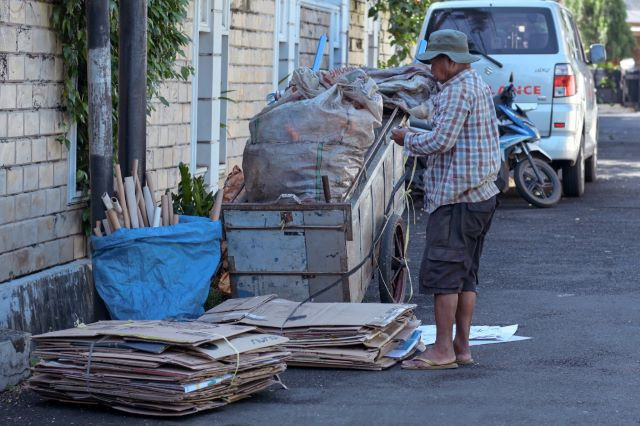Popular Reads
Top Results
Can't find what you're looking for?
View all search resultsPopular Reads
Top Results
Can't find what you're looking for?
View all search resultsHistoric Bagan Siapiapi: A model city for pluralism
With more than 100 exotic Buddhist temples, Bagan Siapiapi in Rokan Hilir, Riau, is undoubtedly a must-see for heritage lovers and advocators of pluralism
Change text size
Gift Premium Articles
to Anyone
W
ith more than 100 exotic Buddhist temples, Bagan Siapiapi in Rokan Hilir, Riau, is undoubtedly a must-see for heritage lovers and advocators of pluralism.
Oriental express: Two women ride a motorcycle past a temple in Bagan Siapiapi in Rokan Hilir, Riau. Established in the late 19th century by Chinese immigrants, the city has more than 100 temples.
Situated on the northern coast of Sumatra, the city not only attracts visitors for its Chinese architecture, but also because its local culture is distinctly unlike that of other ethnic groups in Sumatra.
A five-hour drive from Riau’s capital, Pekanbaru, or a 10-hour bus ride from the North Sumatra capital of Medan brings visitors to the large, newly built administrative compound of Rokan Hilir regency, which proudly tells visitors they are in Bagan Siapiapi, once Indonesia’s biggest fishing port.
The compound is easily recognizable with its wide and smooth streets, a boulevard with a large statue of a fish at its center, and white-painted domed buildings reminiscent of Islamic architecture.
Three kilometers down the road is the city itself, where most Bagan Siapiapi residents live and carry out their day-to-day business.
In contrast to the buildings in the administrative compound, furnished in Melayu (Malay) and Islamic tones, the buildings in the town are mostly built in a traditional Chinese architectural style.
Houses belonging to locals, for example, are mostly built from wood, and have living rooms that also serve as the family’s worshiping altar. Every morning, the streets of Bagan Siapiapi are littered with altars packed with hio (joss sticks) and plates of offerings.
It takes around an hour to circle the town, taking in the city’s iconic buildings, including the 120-year-old In Hok Kiong temple, a regent office and the upmarket Bank Rakyat Indonesia building, the bank’s historic second branch in Indonesia.
Formerly under the administration of Bengkalis regency, Bagan Siapiapi was recently appointed as the capital of Rokan Hilir regency, which was established in 1999.
Bagan Siapiapi is a model Indonesian city in terms of pluralism and tolerance, as residents of various ethnicities have lived harmoniously here for decades without many incidents.
JP/IRMA
According to Rokan Hilir administration, the regency has more than 570,000 residents, 53 percent of whom are of Malay ethnicity, 22 percent Javanese, 12 percent Chinese, 8 percent Batak, 6 percent Minang and the remaining 4 percent are of other ethnic backgrounds. It also reports that 87 percent of the city’s residents are Muslim.
However, Bagan Siapiapi is deemed unique by most visitors. Of the city population of 7,400, almost 90 percent are Chinese-Indonesian, followed by smaller ethnic groups including Malay and Batak.
With a relatively homogeneous community, it is not surprising that the Chinese community in Bagan Siapiapi in most cases are more comfortable speaking Chinese than Indonesian.
“I have spoken [Chinese] more often since I was born. I’m sorry if you find my Indonesian terrible,” said A Kok, 41, a souvenir shop owner, smiling as he spoke in broken Indonesian. Consequently, the non-Chinese residents of Bagan Siapiapi also find it important to learn Chinese.
“By mastering [Chinese], you can interact better with people here, for example when shopping at the market or meeting people in your neighborhood,” said Baringin, 50, an ethnic Batak man who has been living in the city for decades.
The history of Bagan Siapiapi dates back to the late 19th century when a group of wealthy Chinese fishermen fled their hometown in Fujian province, seeking refuge from the Siamese authorities.
After weeks at sea, their boat was stranded on a peninsula on Sumatra’s northern coast. Only 18 people survived, including ship commander Ang Mie Kui, who later became known by locals as the founder of Bagan Siapiapi.
On realizing the enormous fishing potential of the area, the crew decided to settle in the area and invited relatives and friends back home to join them. By the 20th century, the peninsula had become a crowded city with Chinese influences dominating its architecture and culture.
“At the time, the nearest indigenous community was around 40 kilometers away from the Bagan Siapiapi coastline. So, the [Chinese] newcomers found almost no competitors and resistance from locals when developing the area,” Rokan Hilir tourism official Ahmad Arslan said.
Bagan Siapiapi is synonymous with temples. Many of these temples were built by its first Chinese inhabitants and are reserved for family members, and ownership is passed on from one generation to the next, Achmad said.
Silent investment: A man passes a series of four-storey buildings used to breed swallows in Chinatown, Bagan Siapiapi. The city produces top quality swallow nests, making it one of the area’s most important commodities. JP/Hasyim Widhiarto
The city’s rapid rise to wealth was also supported by the Dutch colonial administration, which in 1901 decided to turn Bagan Siapiapi into Indonesia’s first modern fishing port.
Working with the local community, the Dutch administration built public facilities including schools, hospitals, detention centers, a telephone network, tap water facilities and electric generators, turning Bagan Siapiapi into one of the busiest fishing ports on the Malacca Strait.
However, following a sharp decline in fish stocks in the 1950s because of heavy sedimentation and overfishing, today little remains of the city’s former glory.
Residents of Bagan Siapiapi now rely more on trading and cultiva-tion of swallow nests, sold for the famous Chinese delicacy, birds’ nest soup.
The harvested nests fetch high prices and are much sought after in Singapore, Malaysia and Hong Kong, and have turned the city into a reputable swallow nest exporter.
Despite its historical glamour and pride in diversity, Bagan Siapiapi traveled a bumpy road to forging ethnic harmony, having witnessed several bloody ethnic clashes along the way.
Relations between the ethnic Chinese and indigenous residents took a turn for the worse for the first time in a deadly brawl following the Indonesia’s declaration of independence on Aug. 17, 1945.
In his book, Gema Proklamasi Kemerdekaan Republik Indonesia dalam Peristiwa Bagan Siapiapi (The Echo of Indonesian Independence Declaration Day in the Bagan Siapiapi Incident), published in 2006, noted Riau artist and historian Sudarno Wahyudin says this conflict erupted when indigenous residents, most of them of Malay ethnicity, became angry with the Chinese community after the latter raised the Chinese Kuo Min Tang party flag instead of the Indonesian red-and-white flag.
The conflict, which claimed the life of high-profile Chinese leader captain Lhoy Chin Poh, was eventually settled after leaders of the conflicting parties agreed to a cease-fire.
Then, in 1946, pushed partly by ethnic sentiment and the social divide, a group of Indonesian soldiers revolted against Jakarta, and waged a war against the ethnic Chinese population of Bagan Siapiapi.
At least 3,000 people were killed on both sides. The insurgency was not quashed until several years later, when troops from Java liberated Bagan Siapiapi from its oppressors.
Residents of Rokan Hilir and Bagan Siapiapi are now proud of their ethnic tolerance, which can be witnessed in the Chinese community’s traditional barge-burning ceremony — held each year on the 15th and 16th days of the fifth month of the Chinese lunar calendar.
Known locally as Go Ge Cap Lak, this unique event is held to honor the sea gods who guided Bagan Siapiapi’s ancestors to find land.
The ceremony begins with a mass prayer ceremony, where pilgrims burn large joss sticks and present offerings comprising cakes, fruit, pork, fish or chicken.
On the following day, a replica of wooden barge is carried from In Hok Kiang temple to a small square on Jl. Perniagaan in a parade joined by pilgrims and representatives of all temples in the city. Each representative wears a specific uniform that represents their temple.
Once the barge arrives at the burning site, pilgrims throw their yellow gift papers onto the top deck, to be burned together with it.
The latest barge-burning ceremony, held in June, attracted more than 10,000 people, including local and international visitors, some of whom were residents of the city who had long since moved to other areas or overseas.
“I am aware that most Indonesians have a prejudice that Chinese people like us are not nationalistic.
But I can assure you that those born in Bagan Siapiapi would always call this city and Indonesia home,” said A Kok, a fourth-generation resident of the city.












